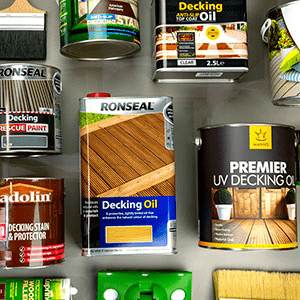Wooden Beam Treatment FAQ's
Do I need to treat my wooden beams?
Yes. It's always a good idea to treat all wood, especially in high moisture environments like kitchens and bathrooms. Moisture can get into the grain of the wood, make it swell or contract and at the very worst cause fungal episodes such as mould. Even central heating can make wood dry out which leads to cracking and warping. Application of an oil or wax every 2-3 years can maintain a seal and keep your wood looking it's best.
Do wooden beams have to be sanded before applying any products?
This depends on the type of wooden beams you have. If they are very old, uneven rustic beams, sanding may be difficult. If they are more modern, reproduction beams that have a smooth surface then it is always a good idea to sand structurally sound wood before applying any product. This removes any traces of previous product or contaminates, smooths out any defects and re-opens pores on the wood surface so it's ready to accept the wood stain or oil.
How can I treat period cottage wooden beams that are around 300 years old?
This entirely depends on their current state. If they are painted you then have two options: strip them using a dedicated paint stripper / remover and then use a beeswax polish to show off their natural beauty or repaint them to rejuvenate the finish. If re-painting, it should be noted that you should only paint over sound coatings and not paint that is flaking or peeling.
Bare wood can be treated with a beeswax polish or a nourishing wood oil.
How can I keep interior wooden beams nourished and protected?
To keep wood nourished and protected, it is recommended to use an oil. There are many types of oils and they all have different looks. Traditional oils like Linseed oil, available as both boiled linseed oil, for a quicker drying finish with an attractive ruby tint and raw linseed oil for the most natural, nourishing finish you can can put on wood. Morrells Tung Oil is another traditional oil, derived from nuts from the Tung tree, giving a luxurious, matt finish.
Rustins Danish Oil is blended from natural oils and polymers. It dries to a satin finish giving wood a warm tint after several coats.
Advice needed on how to seal interior Oak beams?
There are many ways to treat oak beams and still retain their character, depending on the desired look. For best results and maximum compatibility, make sure all previous coatings are removed with a suitable wood stripper / remover. If a colour change is required, a wood stain such as Manns Classic Oak Stain can be used, or alternatively any other suitable product from our wood stain range. The beams should then be sealed with a wood wax, oil or varnish, depending on the desired result.
How can I achieve the traditional black finish look on my Oak beams?
Traditionally, Oak beams were painted black in the 19th century with a primitive paint with ingredients which included coal and tar deposits, giving them a black colour. This can be reproduced using modern, water based paints including this range of Dulux Trade paints, which include gloss, satin and more contemporary matt finishes.
You can also achieve this look in a number of other ways. With a wood stain / dye such as Manns Classic Wood Dye in black and then overcoating with a hard wax oil. Some hard wax oils do contain a colour, such as Fiddes Hard Wax Oil Tints. "Onyx" is a dark, black colour and would be the perfect top coat for your black stained beams to give them a natural-looking finish.
How much oil should be applied to interior beams?
For previously oiled or bare wood beams, this can depend on how dry the timber is. Any type of wood oil should be applied thinly and evenly then allowed to dry in accordance with the drying time on the tin or container. Most types of oil require just 2 or 3 thin coats but if the beams still feel dry, additional thin coats can be applied.
If the oil finish becomes tacky or sticky, this is an indication that too much oil has been applied. In this instance, the over applied excess oil can be removed with a lint-free or microfibre cloth dampened with white spirit.
How do I treat woodworm in Oak beams?
Any of our range of woodworm treatments can be considered an effective treatment, from cost effective treatment for larger areas to treatment with a fine tipped nozzle or spray for smaller areas.
It is recommended that once the woodworm treatment is dry, affected areas should be treated with a suitable wood preserver, both interior and exterior projects alike. This now protected area can then be finished with your chosen wood oil, paint, woodstain or varnish or lacquer.
What is the best way to protect exterior wood beams?
It is always recommended to preserve exterior wood. This will protect it from wood boring insects, rot, mould and fungi. Barrettine Premier Wood Preserver does all of this and is available in a range of wood colours and a clear option for an all-in-one solution that contains wax so will not require a top coat.
Alternatively, Barrettine Premier Universal Preserver is also available but does not contain any wax. This, as it's name suggests, is compatible with nearly any suitable top coating of wood paint, wood stain, or exterior wood varnish for the perfect look.
For a traditional black look on new exterior beams, consider Ronseal Total Wood Preservative which will both colour the wood black and protect the beams from mould, algae and insect attack.
Can I paint exterior wooden beams?
Absolutely. It is recommended that it is first treated with a wood preservative that does not contain wax, such as Barrettine Premier Universal Preserver and then treated with a suitable exterior wood paint.
Products suitable for wooden beams
The following products can be used on a variety of projects with many being suitable for old and new, bare wood and previously treated wooden beams.
- Wood strippers / removers
- Wood waxes
- Wood oils
- Wood stains
- Wood preservative treaments
- Wood paints
- Woodworm treatments
Related Wooden Beam Finishing Blog Posts
Disclaimer: Whilst every attempt has been made to provide product information that is as accurate as possible, it's important to clarify that trees and the wood that they produce can be affected by many factors. For example, the same species of tree grown in the same wood, even in close proximity, will be affected by age along with the amount of sunlight and water they receive. Other naturally occurring biological and environmental factors will also influence the density and grain of the wood as well as the moisture and oil content of the timber. No two trees are the same, meaning each piece of wood has the potential to look and react differently to the same wood finish. For example, product adhesion, colour variations, absorption rates and sheen levels. It is for this reason that we always strongly recommend carrying out test areas before starting any project


